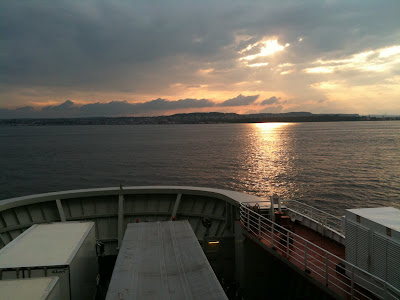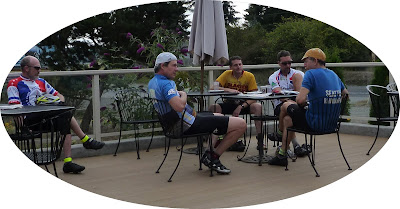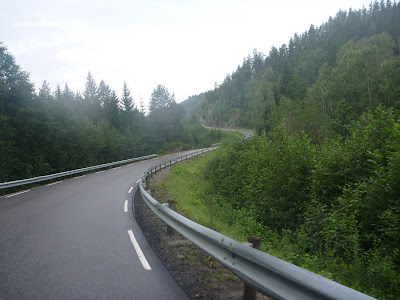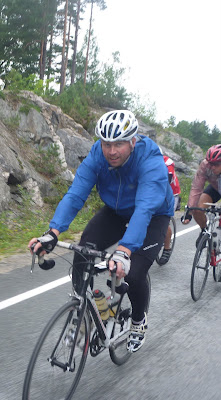Knowing the general approach was only part of the battle. I still might have to deal with a bicycle path which diverged from the main road on the cue sheet or which took me through an intersection in such a way that I could not see the signs. Or perhaps the road on which we should continue would take a left or a right at an intersection which was not noted on the cue sheet. I had one extra weapon in my navigation arsenal - my GPS. This might have solved my navigational challenges better but for one fundamental problem. I had programmed a track into the GPS based on a map of the 2005 route, not based on the cue sheet which I didn't have at the time. My track creation skills were less than perfect in the first place and then the route had changed, particularly on the way into some changed overnight control locations. At least, however, I could watch the map on the GPS and slow down to be more careful about navigation when the lines on the screen stopped following our actions on the road. When riding with others, I'd ask them if they were sure about the direction followed. Usually they were.
About 40 kilometers into the day, the line on my GPS made a left turn where the cue sheet was silent. I slowed the other riders enough to allow us to be the beneficiary of a course correction shouted from a porch by a bathrobed fellow who seemed bemused at all the cyclists that had been by in the morning. I found out later that this had been a good save; continuing straight, we could have reconnected with the route, but only after extra distance, some navigational guessing, and a long stretch of gravel road.

Twenty five kilometers later, we found a bakery in Torup and the opportunity for delicious baked goods, for water bottle refilling, and for a little sit and rest. (Also a smoke, but I wasn't tempted yet). Also coffee. Not to seem ungrateful, but frankly most of the coffee I had in Scandinavia was horrible. This cup was no exception, but I was happy to have it nonetheless. As we were preparing to leave, John Evans rode up. Unhappily for him, he had taken the extra distance, extra navigation, gravel road option earlier. Happily for me, John would provide good riding company as we rode more or less together for the next 100miles, both with and without our pack of Danes.
The "Welcome Bikers" sign outside Svenljunga beckoned around lunchtime.

However, it called to cyclists of the motor-assisted sort; we had apparently stumbled on the Sturgis of Sweden. In general, this was no problem. Like virtually all the motorists that I encountered in the three countries of the ride, the bikers were unfailingly courteous of us on bicycles. The bikers did make lunch a bit more complicated than usual. The restaurants were packed, making lunch a slow process. (Foregoing lunch was not even considered). Also, it would appear that Swedish bikers are untrustworthy with credit cards, so the stores and restaurant that I visited all had "no cards" signs out. I had been hoping that I could use my bank card to avoid getting a different currency in each of the three countries of the ride, but now I was reduced to going around to my fellow riders and begging for Swedish crowns.
Thirty kilometers later, completely befuddled by the bike lanes and highways on the way into the town of Borås, John and I stopped near the train station for our second attempt at asking a local for directions. The first had elicited a "yes, I think you could go that way, or perhaps this other way" response that had solved none of our confusion. The second time was a charm, however, as we received some very precise directions out of town to our next destination. Upon our successful execution of these directions, John suggested that we replace the cue sheet with the nice young woman that had provided them. I'm certain that his motivations were entirely navigational and had nothing to do with the striking nordic looks of our guiding angel.
On the way up the hill out of Borås, I stopped for a rest and John disappeared up the road ahead. I was now, to the best of my knowledge, dead last among the riders. The prestige of "lanterne rouge" designation provided small comfort, but the "better DFL than DNF" admonition was sufficiently motivating to keep me going to the convenience store control in Alingsås. Several riders were still there, providing me with connection to the field. The father-daughter Swedish riders provided good directions out of town before leaving.
Despite being last on the road, I felt pretty good. Fifty kilometers later, however, I found myself totally lost. The highway on the route sheet was clearly marked with a "no bicycles" indication. My GPS track was no help on this section where the 2005 and 2009 routes diverged substantially. Following the bike route that I vainly hoped might lead back to the highway, I was soon dodging Saturday night party-goers on the cobbled streets of Trollhattan. And I had not even reached the two ominous sounding cues on the route sheet that both identically read "Y-kryds ved ôre Sjö - ingen kendteskilte/no known signs." Whatever that might mean.
Finally I gave up all hope of finding the route and programmed the overnight hotel into the GPS and beseeched it to find me a way there. Which it did. I'm convinced that it found the darkest, hilliest, most deserted route to the overnight stop, but it got me there. After gingerly carrying my bike downstairs to the basement for the second night in a row, I was directed to the room I would share with John Evans. It appeared that he had not preceded me there by too much and I was soon showered and down in the dining area sharing lasagna and beer with the other late arrivals. With only 305km on the second day, it was not even 1AM when I went to bed with the prospect of nearly 5 hours of sleep.
A word about the support on this ride. To my amazement, the entire support crew consisted of organizer Per Rasmussen and his wife and daughter. They would drive the bags to the overnight location and then split duties. The women would care for us on arrival each night, then sleep. Per would sleep first and then care for us at breakfast. The good humor and helpful assistance offered by Betty and her daughter even to the latest arrivals each night cheered me tremendously. Thanks to them.
DAY THREE - Getting Better
With almost 350km to cover, Sunday would be the longest day of the ride. (In prior years the second overnight was further along the route, providing a more normal distribution of distance than the 340/305/346/230 of the 2009 edition). Seventy kilometers after breakfast would be the first control of the day in Ed, which seems like a friendly name for a town and which was the last control in Sweden. I rode some of this stretch with John and the six Danes and some alone. I felt pretty good and was content with my exploration of the better-each-day hypothesis. The camera suggests a somewhat grimmer determination:

After entering Norway, the route ran north for a while along the Iddefjord which separates Norway from Sweden (which, to my modest confusion, is to the west of Norway here). As a cool drizzle settled in and as the route added more hills (short rollers), I could feel my legs coming back. It was a nice sensation to hit the rises pretty hard and feel good doing it. We enjoyed a nice lunch stop in Halden, Norway. We waited a while for one of the Danes, who was not feeling as chipper as the rest of us, but before long we were pushing on to the control in Rakkestad (km 813), which we reached before 4pm.

After Rakkestad, the route headed north east of the Glomma (largest river in Norway) to Askim before turning south and then west to the last ferry of the brevet at Moss. Along the way, I lost track of my riding companions. John rode off ahead and the others stopped somewhere. I also blithely followed the cue sheet on roads clearly not meant for bicycles rather than repeat the bike path misadventures of the previous evening. As a result, I found myself the lone rider on the 7:30 ferry from Moss to Horten across the Oslofjord. A beautiful sky beckoned.

With 100km to go from Horten to the overnight, I was expecting, but not dreading, a long evening of riding. Once off the ferry, I again followed the highway instead of the bike paths for the first part of the route out of town. In the middle of a no-shoulder tunnel, this started to seem like a really bad idea, but I survived. About 15 km or so after the ferry I came upon the father-daughter cyclists having an animated discussion in Swedish. For my benefit, Lasse summarized: "This is shit!" he said, pounding the route sheet. Apparently they had spent at least a half hour lost in the last town. It was also apparently not their first such incident of the day. They had started the day early before breakfast and were clearly not happy to be losing time. I suggested that we pool our navigational resources and ride together, at least to the next control in Larvik. They liked the idea of having a GPS on their side, so off we went.
Happy to say, our navigational misadventures were few and short before we found the lovely, if hilly, road into Sandefjord and the much less scenic road from there to the next control in Larvik. We arrived in Larvik around 11:30 or so to discover that the ferry terminal (for a ferry to Denmark) that was suggested as the control point had long since closed for the day. After much perplexed wandering, we found a gas station / convenience store and proceeded to fritter away time unnecessarily.
The last 35 kilometers of the day seemed much longer. A series of seemingly gratuitous descents and climbs eventually gave way to a long flat stretch into Skien, our overnight control town. A pretty good rain started just as we were wandering around, quite confused and lost, within 100 meters of the control location. It was nearly 3AM when I stumbled into my room for a shower before dinner. They planned to send John in to share it with me when he arrived. (I never saw him, and found out later that it was 8AM before he came through the control, asked for his bag so he could change to dry gloves, and then immediately headed out again.)
DAY FOUR - Feelin' Groovy
After my shortest sleep of the ride, I joined most of the other riders for breakfast, again receiving sympathetic comments for my late arrival. Others had arrived later, however, and even some of the earlier riders had chosen to sleep longer. So with a quick breakfast and an eagerness to "git 'er done," I left at about 6:30 for the 230km push to the finish. The report on the remaining course forecast a hilly, challenging 105km to the control at Treungen and then an easier 125km to the finish. Although a few left before me, I was one of the first riders on the road.
The first 60 kilometers included some of the hilliest and prettiest riding on the brevet leading to the town of Drangedal. (In a sign of my mental decomposition, I found the name of the town hilarious. "Where did the beer go?" "We Drangedal!" This amused me for longer than I care to admit. Then this:
"Phenomenal cycling power. Itty bitty living space." Ha. Ha. Laughter is a sign. Of delirium, perhaps.
To my surprise, I saw only a handful of riders go by along this stretch and I was feeling pretty full of myself when I stopped for a mid-morning snack at a convenience store. A huge pack of riders came in as I was leaving and I vowed to conserve enough energy that I could hang onto at least some of that group when it came by later.
The forty kilometers to Treungen included the most sustained climb of the ride, up 500+ meters to the alpine ski resort of Gautefall. To my further surprise, only one rider came by me on the way up the hill or down the other side. It must be my intensely competitive nature, but this further improved my good mood of the day.
Just before the control, the route sheet said to take a left onto 41 and go 1 km to the control at Treungen. With local knowledge, other riders instead went right a short ways where they could find many control options. Following the route sheet to the left, I found just one, a gas station/convenience store. Once again, however, the quality of the offerings pleasantly surprised me as it had at many a convenience store along the route. A less pleasant surprise was the reaction of the clerk to my request for a stamp. "It is not usual," he said and made it clear that no amount of pleading would yield a stamp. I settled for a receipt and made my way down the road.
In the next stretch I was overtaken by one rider and then swept up by a group of three Danish riders. These included Per and Flemming who were in the group with which I had tried to ride on the first day. I recalled, and was reminded at the next control, that Per was the one who would smoke a pipe at each stop. Apparently this works well for him; he has many 1200s to his credit.

The third rider was Thomas, who wanted to know if I knew Brian Ohlemeier in Seattle. Thomas had ridden part of the way to Brest with Brian at PBP 2007 before dropping off, but still finishing in a fast time. Latching onto these guys was a kick. They were strong and fast, but with few hills remaining (and perhaps a helping of discreet assistance), I could stay with them.
We rode into the penultimate control at a campground. In 2005, there had been a camp store and possibly more. In 2009, we instead found a common room showing signs of a desultory renovation project. The man who greeted us, however, was quite enthusiastic to hear of our ride. Apparently he was also delighted to learn that I had come from the USA and that a rider from Australia was just behind. He reported that it had been over ten years since he had seen an American and that he had never ever seen an Australian. He insisted on making a pot of coffee for us. Thus stoked for the 75 km homestretch, we headed out.

Following the Tovdalselva river to the sea, we zipped along the scenic and flat next section of the course. To my surprise, Thomas called for a food stop in Birkeland, only about 30km from the end. Jan-Erik and Russ rolled up with another rider. I had a soda while some riders waited for real food. Seized by stiffening legs and by a burning desire to finish the ride, I took off alone, figuring I'd see the others soon.
At an intersection less than five kilometers from the finish, I studied the signs, the cue sheet, and the GPS for hints about the route. Finally, I headed off downhill to the right. Before I got far, I heard my name being called and looked around to see Jan-Erik racing down from the intersection after me. He escorted me back up and pointed the correct direction (uphill to the left). Thus saved from much lost wandering, I happily followed him and Russ and the other rider to the finish, where we arrived at 7:20pm, nearly 85 hours after starting this adventure.
Celebratory beer ensued.
 Pre-ride coffee - Seattle ferry terminal
Pre-ride coffee - Seattle ferry terminal
































